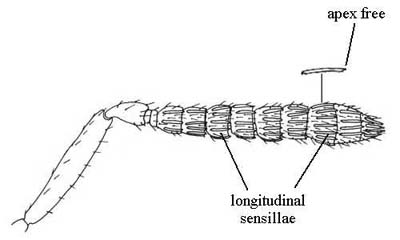Universal Chalcidoidea Database
Diagnostic characters of chalcidoids
Diagnostic characters | Morphology and terminology | Notes on famalies
1. Macropterous forms: fore wing never with any enclosed cells.
2. Antenna almost always with fewer than 15 segments (only one or two species of Eucharitidae with more), very rarely with more than 13.
3. Antenna with scape elongate giving it an elbowed appearance.
4. Longitudinal sensillae (multiporous plate sensillae) present on at least one flagellar segment.
5. Longitudinal sensillae (multiporous-plate sensillae) on antenna unique - with distal apex free (see below). (Longitudinal sensillae present in some Ichneumonoidea, but never with apex free.)

6. Flagellum, especially in females, differentiated into funicle and clava, the clava conspicuously larger than any preceding segment and composed of two or more fused segments.
7. Body commonly metallic, frequently strongly so.
8. Length mostly not more than 5mm, but a few species more than 20mm.
9. Prepectus present, externally visible as a relatively small to large triangular or subtriangular sclerite that clearly separates the pronotum and tegula. In all other microhmyenoptera the prepectus is absent and the pronotum touches the tegula.
Last updated 07-Jun-2004 Dr B R Pitkin